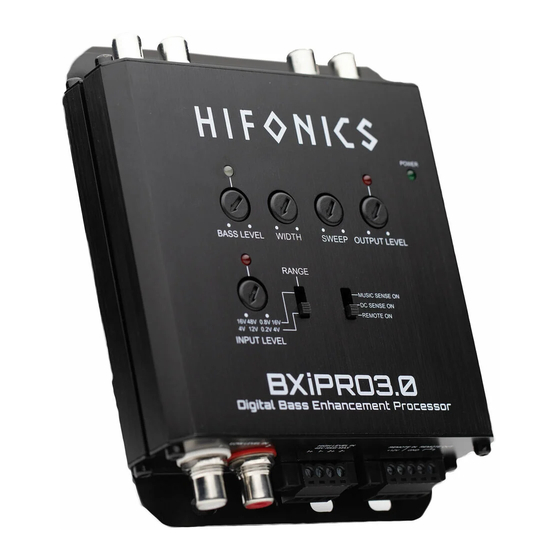Hifonics BXiPRO3.0 Benutzerhandbuch - Seite 9
Blättern Sie online oder laden Sie pdf Benutzerhandbuch für Computer Hardware Hifonics BXiPRO3.0 herunter. Hifonics BXiPRO3.0 10 Seiten. Digital bass enhancement processor

Diagnostics & Trouble Shooting
The key to finding the problem in a troubled sound system is to isolate parts of that
system in a logical fashion to track down the fault and correct the issue.
The diagnostic system will not shut down the crossover or the amplifier(s), although
the amplifier(s) own protection circuitry may shut the amplifier(s) down, should a fault
status occur. You will need to consult the owners manual for that particular amplifier.
Low Output
Power
Hiss, or
White Noise
Electrical
Interference
Ticking or
Whine that
changes
with engine
RPM
Constant
Whine
1) Check that level controls have been set up properly.
2) Make sure that the battery voltage, as measured at the
amplifier(s) and crossover +12 volt and ground terminals,
is 11 volts or more.
3) Check all +12 volt and ground connections.
1) High levels of white noise usually occur when level controls are
turned up too high – reduce the levels until the noise is no
longer present.
2) Another problem that can cause excessive hiss, is a noisy
head unit – unplug the crossover input RCA's, and if the hiss level
reduces, the source unit is at fault.
The inside of an automobile is a very hostile electrical environment. The
multitude of electrical systems, such as the ignition system, alternator, fuel
pumps, and air conditioners, create radiated electrical fields, as well as
noise on the +12 volt supply and ground. To try and eliminate this noise,
run a wire from the radio ground wire to the ground input on the equalizer.
1) This problem could be caused by radiation pickup of RCA cables
that are too close to a fuel pump or a distributor.
2) Check that the head unit ground is connected straight to the
vehicle chassis and does not use factory wiring for ground.
3) Try to supply the head unit with a clean +12 volt supply directly
from the battery +, instead of using a supply from the in-dash
wiring/fusebox.
This type of noise can be more difficult to pinpoint, but is usually
caused by some kind of instability, causing oscillations in the
system.
1) Check all connections, (especially for good grounds).
2) Make sure that no speaker leads are shorting to exposed metal
on the vehicle chassis.
3) RCA cable are notorious for their problematic nature, so check
that these are good, especially the shield connections.
